Coventry University Digital Marketing: Co-creation Individual Report
VerifiedAdded on 2021/08/20
|17
|4155
|238
Report
AI Summary
This individual report, submitted for a Digital Marketing course at Coventry University, examines the concept of co-creation as a method for enhancing customer relationships and driving innovation. The report, approximately 2,750 words, explores co-creation as an online approach for new product development, incorporating external stakeholder input. It analyzes three organizations—IKEA, Heineken, and a third unspecified company—to demonstrate the application of co-creation theories and branded content on social media. The report discusses the stages, channels, and requirements of co-creation, evaluating consumer interest and providing recommendations for innovation managers to improve their businesses by delivering seamless co-creation experiences. It draws on academic research and theories from Verleye (2015), Hsieh & Chang (2016), and Elsharnouby & Mahrous (2015), focusing on customer perspectives, psychological mechanisms, and e-service quality within co-creation environments.
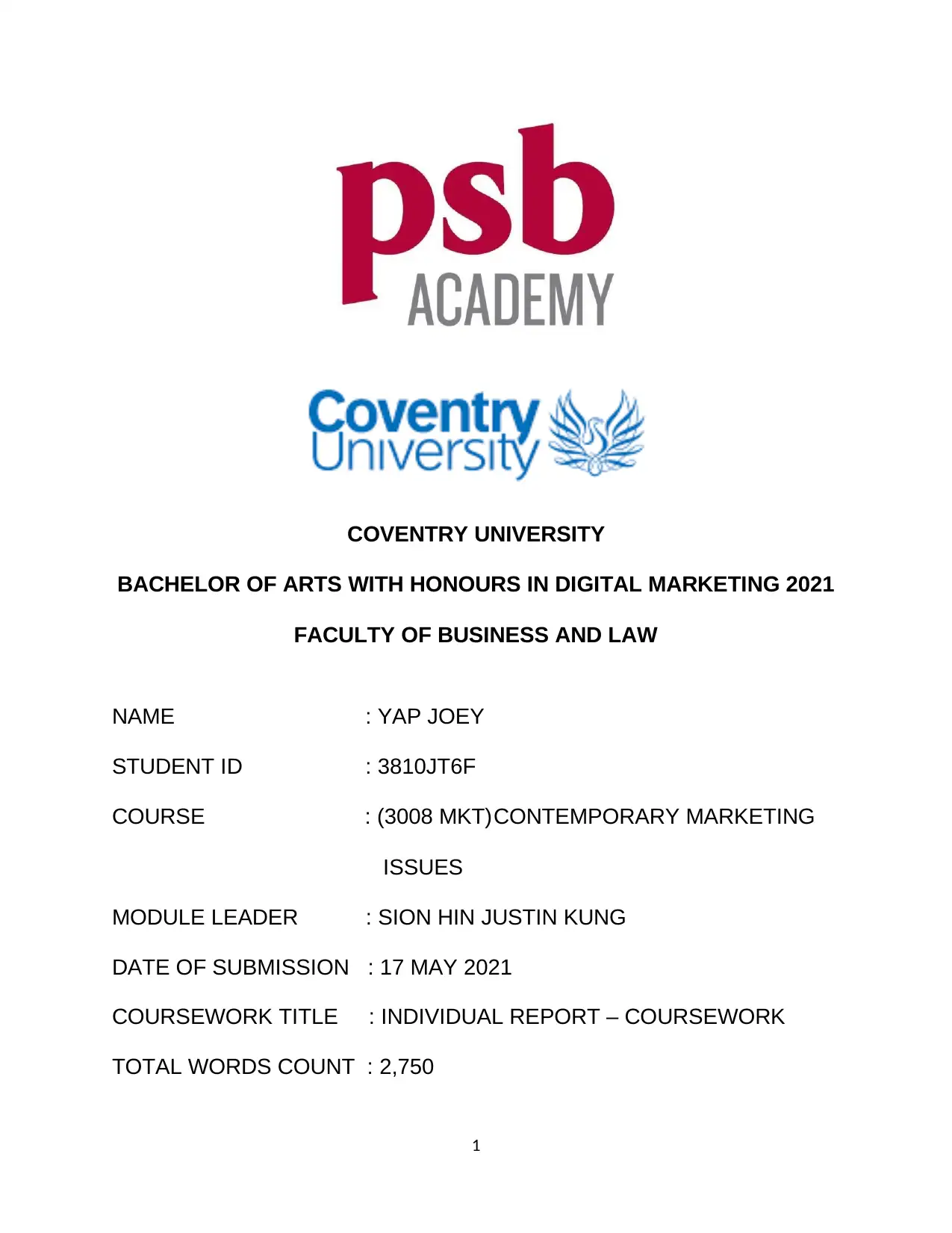
1
COVENTRY UNIVERSITY
BACHELOR OF ARTS WITH HONOURS IN DIGITAL MARKETING 2021
FACULTY OF BUSINESS AND LAW
NAME : YAP JOEY
STUDENT ID : 3810JT6F
COURSE : (3008 MKT) CONTEMPORARY MARKETING
ISSUES
MODULE LEADER : SION HIN JUSTIN KUNG
DATE OF SUBMISSION : 17 MAY 2021
COURSEWORK TITLE : INDIVIDUAL REPORT – COURSEWORK
TOTAL WORDS COUNT : 2,750
COVENTRY UNIVERSITY
BACHELOR OF ARTS WITH HONOURS IN DIGITAL MARKETING 2021
FACULTY OF BUSINESS AND LAW
NAME : YAP JOEY
STUDENT ID : 3810JT6F
COURSE : (3008 MKT) CONTEMPORARY MARKETING
ISSUES
MODULE LEADER : SION HIN JUSTIN KUNG
DATE OF SUBMISSION : 17 MAY 2021
COURSEWORK TITLE : INDIVIDUAL REPORT – COURSEWORK
TOTAL WORDS COUNT : 2,750
Paraphrase This Document
Need a fresh take? Get an instant paraphrase of this document with our AI Paraphraser
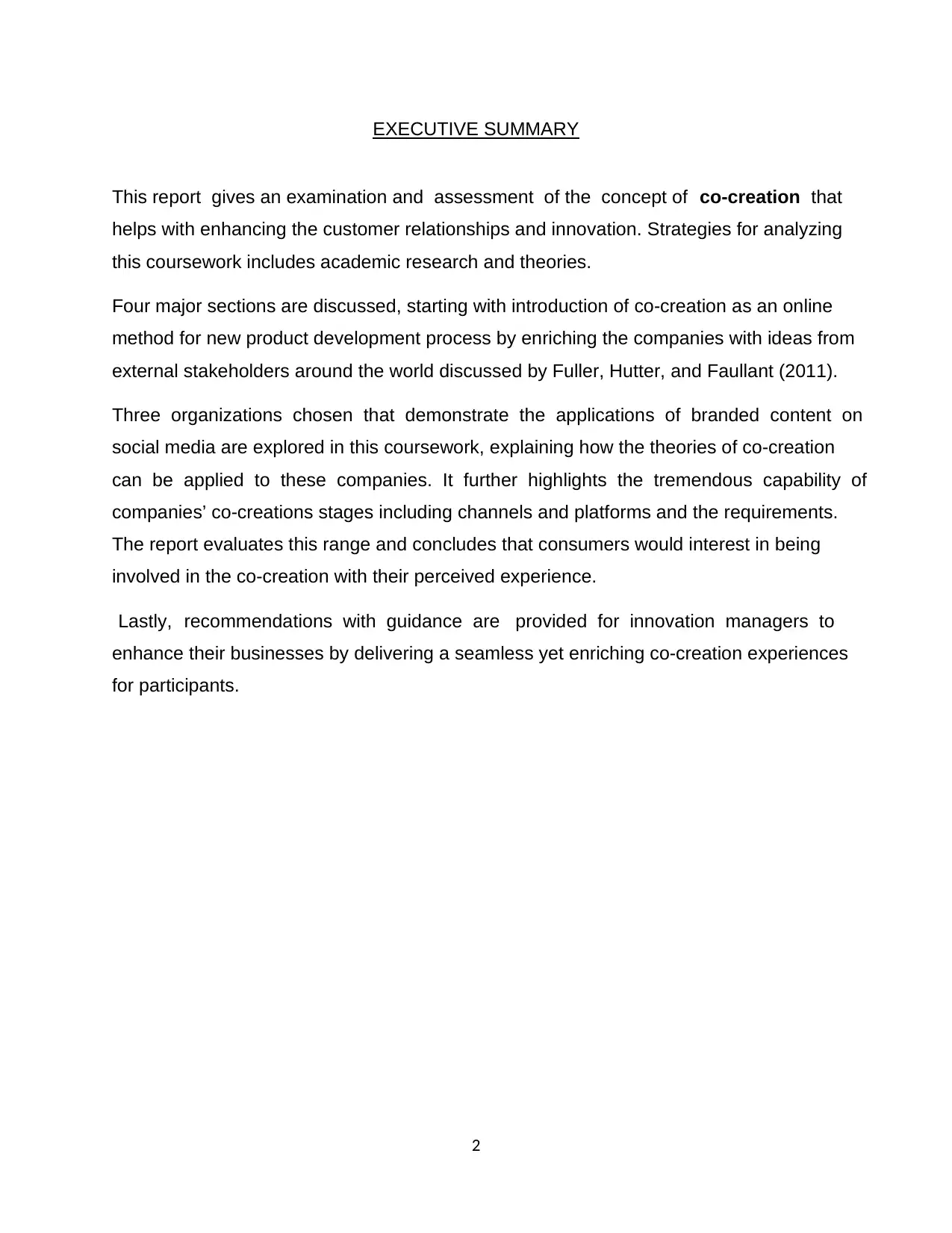
2
EXECUTIVE SUMMARY
This report gives an examination and assessment of the concept of co-creation that
helps with enhancing the customer relationships and innovation. Strategies for analyzing
this coursework includes academic research and theories.
Four major sections are discussed, starting with introduction of co-creation as an online
method for new product development process by enriching the companies with ideas from
external stakeholders around the world discussed by Fuller, Hutter, and Faullant (2011).
Three organizations chosen that demonstrate the applications of branded content on
social media are explored in this coursework, explaining how the theories of co-creation
can be applied to these companies. It further highlights the tremendous capability of
companies’ co-creations stages including channels and platforms and the requirements.
The report evaluates this range and concludes that consumers would interest in being
involved in the co-creation with their perceived experience.
“Lastly, recommendations with guidance are provided for innovation managers to
enhance their businesses by delivering a seamless yet enriching co-creation experiences
for participants.”
EXECUTIVE SUMMARY
This report gives an examination and assessment of the concept of co-creation that
helps with enhancing the customer relationships and innovation. Strategies for analyzing
this coursework includes academic research and theories.
Four major sections are discussed, starting with introduction of co-creation as an online
method for new product development process by enriching the companies with ideas from
external stakeholders around the world discussed by Fuller, Hutter, and Faullant (2011).
Three organizations chosen that demonstrate the applications of branded content on
social media are explored in this coursework, explaining how the theories of co-creation
can be applied to these companies. It further highlights the tremendous capability of
companies’ co-creations stages including channels and platforms and the requirements.
The report evaluates this range and concludes that consumers would interest in being
involved in the co-creation with their perceived experience.
“Lastly, recommendations with guidance are provided for innovation managers to
enhance their businesses by delivering a seamless yet enriching co-creation experiences
for participants.”
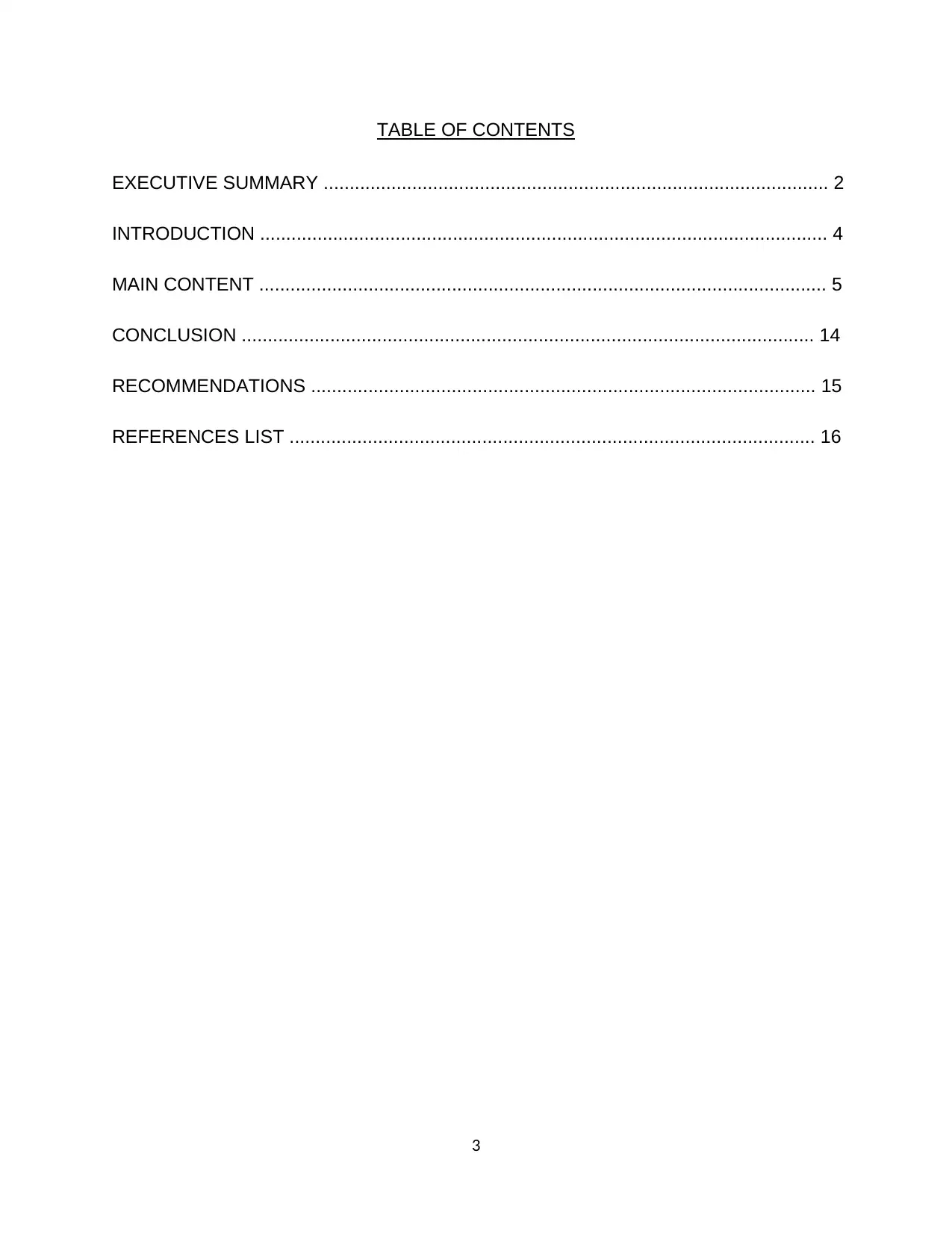
3
TABLE OF CONTENTS
EXECUTIVE SUMMARY ................................................................................................. 2
INTRODUCTION ............................................................................................................. 4
MAIN CONTENT ............................................................................................................. 5
CONCLUSION .............................................................................................................. 14
RECOMMENDATIONS ................................................................................................. 15
REFERENCES LIST ..................................................................................................... 16
TABLE OF CONTENTS
EXECUTIVE SUMMARY ................................................................................................. 2
INTRODUCTION ............................................................................................................. 4
MAIN CONTENT ............................................................................................................. 5
CONCLUSION .............................................................................................................. 14
RECOMMENDATIONS ................................................................................................. 15
REFERENCES LIST ..................................................................................................... 16
⊘ This is a preview!⊘
Do you want full access?
Subscribe today to unlock all pages.

Trusted by 1+ million students worldwide
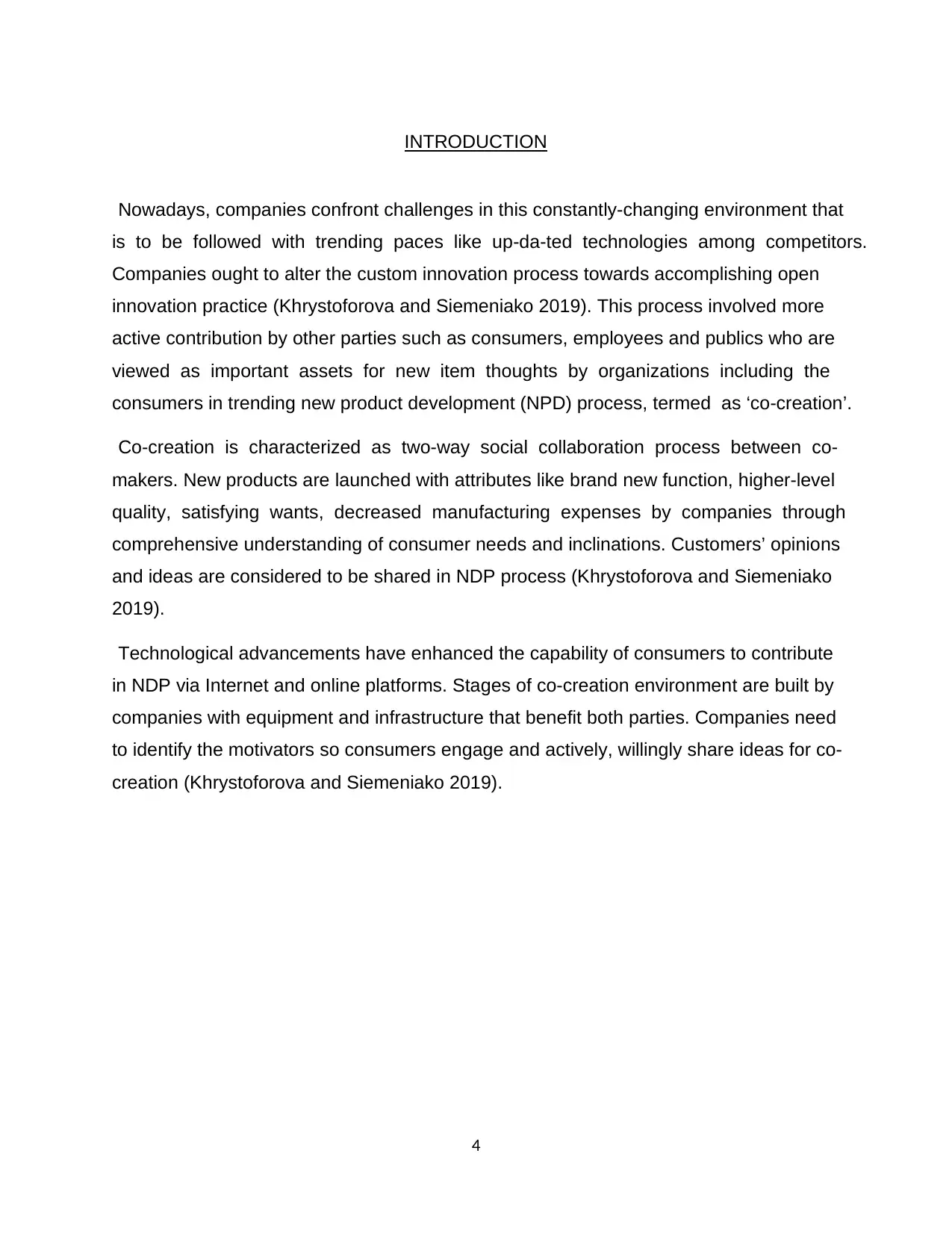
4
INTRODUCTION
“Nowadays, companies confront challenges in this constantly-changing environment that
is to be followed with trending paces like up-da-ted technologies among competitors.
Companies ought to alter the custom innovation process towards accomplishing open
innovation practice (Khrystoforova and Siemeniako 2019). This process involved more
active contribution by other parties such as consumers, employees and publics who are
viewed as important assets for new item thoughts by organizations including the
consumers in trending new product development (NPD) process, termed as ‘co-creation’. ”
“Co-creation is characterized as two-way social collaboration process between co-
makers. New products are launched with attributes like brand new function, higher-level
quality, satisfying wants, decreased manufacturing expenses by companies through
comprehensive understanding of consumer needs and inclinations. Customers’ opinions
and ideas are considered to be shared in NDP process (Khrystoforova and Siemeniako
2019).”
“Technological advancements have enhanced the capability of consumers to contribute
in NDP via Internet and online platforms. Stages of co-creation environment are built by
companies with equipment and infrastructure that benefit both parties. Companies need
to identify the motivators so consumers engage and actively, willingly share ideas for co-
creation (Khrystoforova and Siemeniako 2019).”
INTRODUCTION
“Nowadays, companies confront challenges in this constantly-changing environment that
is to be followed with trending paces like up-da-ted technologies among competitors.
Companies ought to alter the custom innovation process towards accomplishing open
innovation practice (Khrystoforova and Siemeniako 2019). This process involved more
active contribution by other parties such as consumers, employees and publics who are
viewed as important assets for new item thoughts by organizations including the
consumers in trending new product development (NPD) process, termed as ‘co-creation’. ”
“Co-creation is characterized as two-way social collaboration process between co-
makers. New products are launched with attributes like brand new function, higher-level
quality, satisfying wants, decreased manufacturing expenses by companies through
comprehensive understanding of consumer needs and inclinations. Customers’ opinions
and ideas are considered to be shared in NDP process (Khrystoforova and Siemeniako
2019).”
“Technological advancements have enhanced the capability of consumers to contribute
in NDP via Internet and online platforms. Stages of co-creation environment are built by
companies with equipment and infrastructure that benefit both parties. Companies need
to identify the motivators so consumers engage and actively, willingly share ideas for co-
creation (Khrystoforova and Siemeniako 2019).”
Paraphrase This Document
Need a fresh take? Get an instant paraphrase of this document with our AI Paraphraser
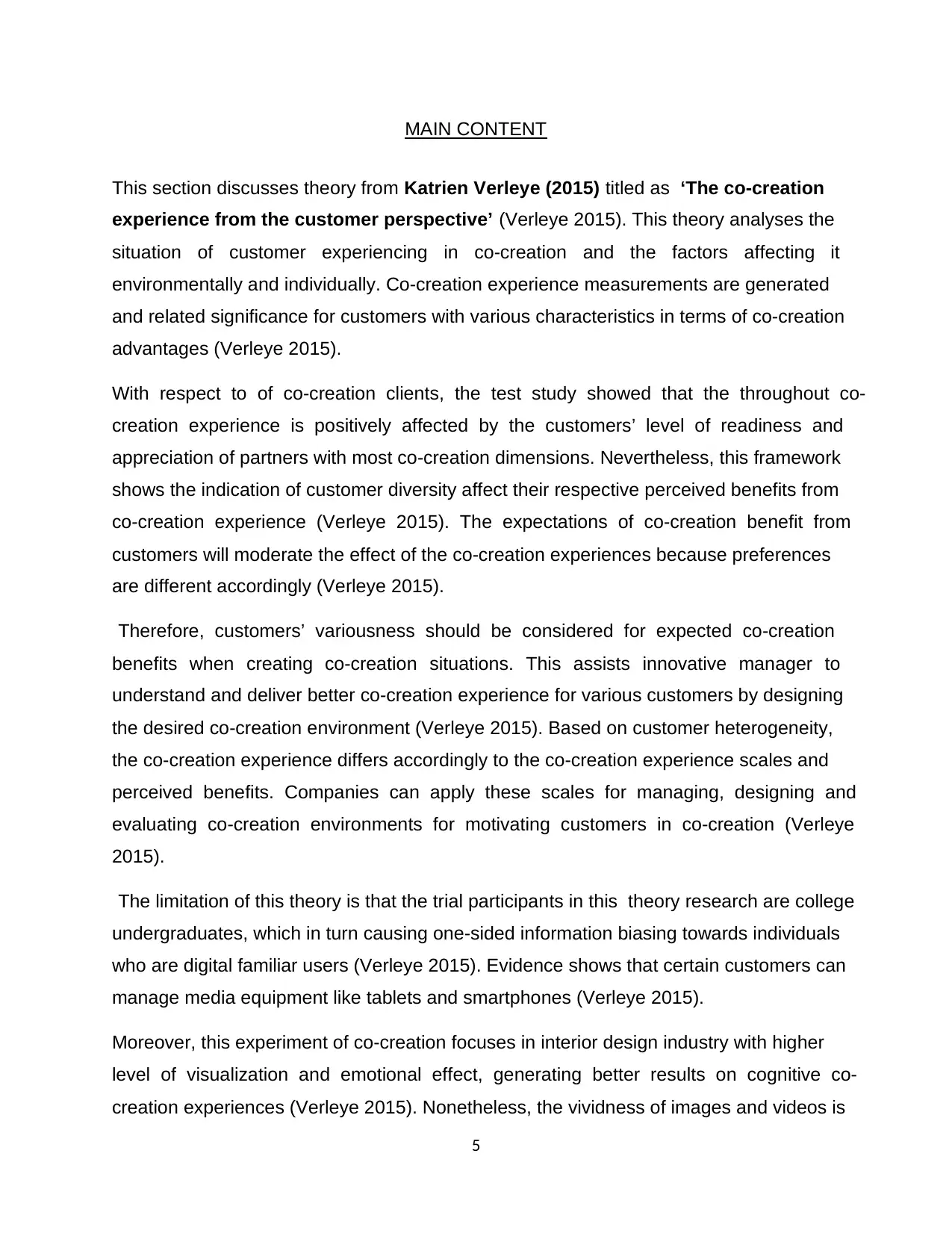
5
MAIN CONTENT
This section discusses theory from Katrien Verleye (2015) titled as ‘The co-creation
experience from the customer perspective’ (Verleye 2015). This theory analyses the
situation of customer experiencing in co-creation and the factors affecting it
environmentally and individually. Co-creation experience measurements are generated
and related significance for customers with various characteristics in terms of co-creation
advantages (Verleye 2015).
With respect to of co-creation clients, the test study showed that the throughout co-
creation experience is positively affected by the customers’ level of readiness and
appreciation of partners with most co-creation dimensions. Nevertheless, this framework
shows the indication of customer diversity affect their respective perceived benefits from
co-creation experience (Verleye 2015). The expectations of co-creation benefit from
customers will moderate the effect of the co-creation experiences because preferences
are different accordingly (Verleye 2015).
“Therefore, customers’ variousness should be considered for expected co-creation
benefits when creating co-creation situations. This assists innovative manager to
understand and deliver better co-creation experience for various customers by designing
the desired co-creation environment (Verleye 2015). Based on customer heterogeneity,
the co-creation experience differs accordingly to the co-creation experience scales and
perceived benefits. Companies can apply these scales for managing, designing and
evaluating co-creation environments for motivating customers in co-creation (Verleye
2015).”
“The limitation of this theory is that the trial participants in this theory research are college
undergraduates, which in turn causing one-sided information biasing towards individuals
who are digital familiar users (Verleye 2015). Evidence shows that certain customers can
manage media equipment like tablets and smartphones (Verleye 2015).”
Moreover, this experiment of co-creation focuses in interior design industry with higher
level of visualization and emotional effect, generating better results on cognitive co-
creation experiences (Verleye 2015). Nonetheless, the vividness of images and videos is
MAIN CONTENT
This section discusses theory from Katrien Verleye (2015) titled as ‘The co-creation
experience from the customer perspective’ (Verleye 2015). This theory analyses the
situation of customer experiencing in co-creation and the factors affecting it
environmentally and individually. Co-creation experience measurements are generated
and related significance for customers with various characteristics in terms of co-creation
advantages (Verleye 2015).
With respect to of co-creation clients, the test study showed that the throughout co-
creation experience is positively affected by the customers’ level of readiness and
appreciation of partners with most co-creation dimensions. Nevertheless, this framework
shows the indication of customer diversity affect their respective perceived benefits from
co-creation experience (Verleye 2015). The expectations of co-creation benefit from
customers will moderate the effect of the co-creation experiences because preferences
are different accordingly (Verleye 2015).
“Therefore, customers’ variousness should be considered for expected co-creation
benefits when creating co-creation situations. This assists innovative manager to
understand and deliver better co-creation experience for various customers by designing
the desired co-creation environment (Verleye 2015). Based on customer heterogeneity,
the co-creation experience differs accordingly to the co-creation experience scales and
perceived benefits. Companies can apply these scales for managing, designing and
evaluating co-creation environments for motivating customers in co-creation (Verleye
2015).”
“The limitation of this theory is that the trial participants in this theory research are college
undergraduates, which in turn causing one-sided information biasing towards individuals
who are digital familiar users (Verleye 2015). Evidence shows that certain customers can
manage media equipment like tablets and smartphones (Verleye 2015).”
Moreover, this experiment of co-creation focuses in interior design industry with higher
level of visualization and emotional effect, generating better results on cognitive co-
creation experiences (Verleye 2015). Nonetheless, the vividness of images and videos is
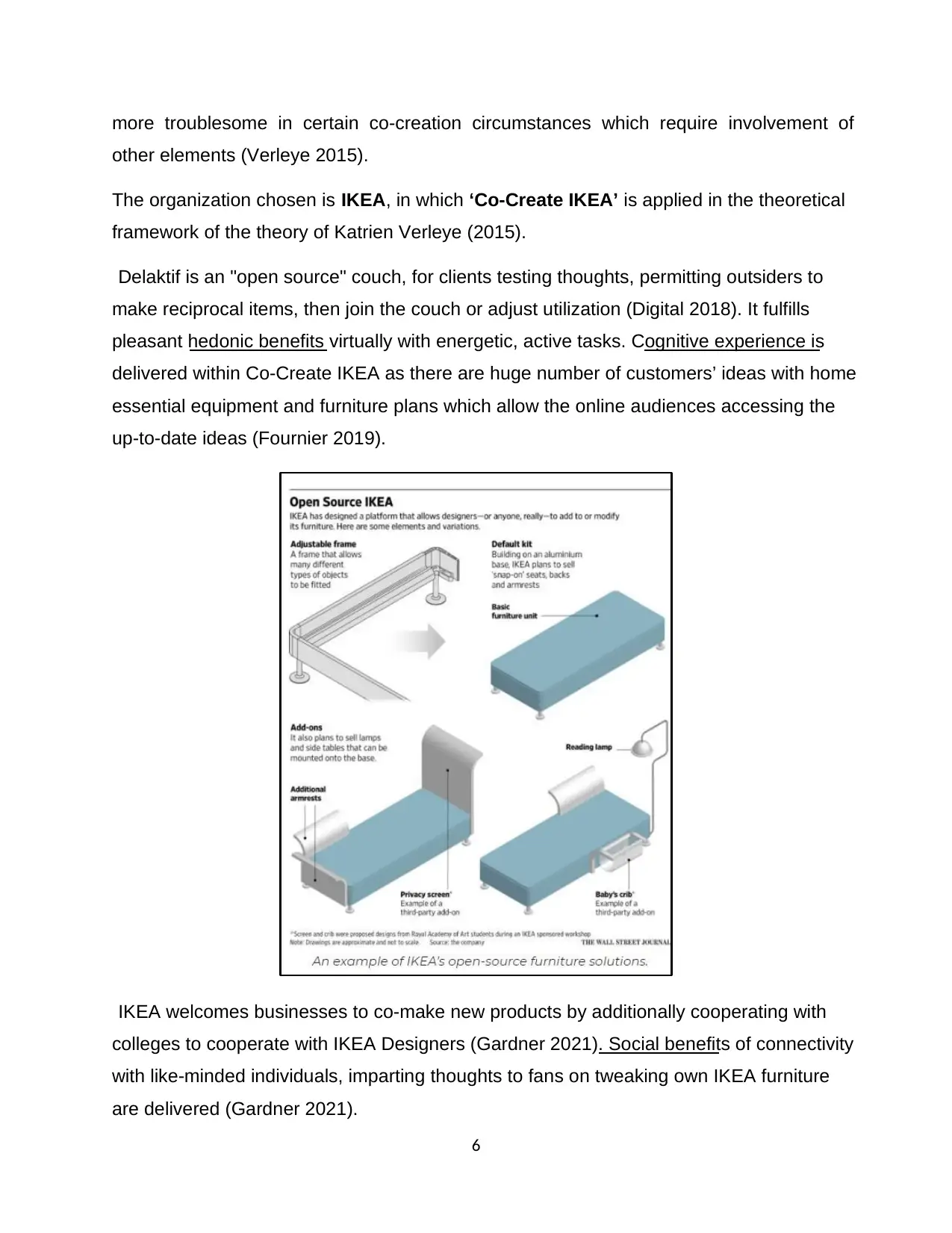
6
more troublesome in certain co-creation circumstances which require involvement of
other elements (Verleye 2015).
The organization chosen is IKEA, in which ‘Co-Create IKEA’ is applied in the theoretical
framework of the theory of Katrien Verleye (2015).
“Delaktif is an "open source" couch, for clients testing thoughts, permitting outsiders to
make reciprocal items, then join the couch or adjust utilization (Digital 2018). It fulfills
pleasant hedonic benefits virtually with energetic, active tasks. Cognitive experience is
delivered within Co-Create IKEA as there are huge number of customers’ ideas with home
essential equipment and furniture plans which allow the online audiences accessing the
up-to-date ideas (Fournier 2019).”
“IKEA welcomes businesses to co-make new products by additionally cooperating with
colleges to cooperate with IKEA Designers (Gardner 2021). Social benefits of connectivity
with like-minded individuals, imparting thoughts to fans on tweaking own IKEA furniture
are delivered (Gardner 2021).”
more troublesome in certain co-creation circumstances which require involvement of
other elements (Verleye 2015).
The organization chosen is IKEA, in which ‘Co-Create IKEA’ is applied in the theoretical
framework of the theory of Katrien Verleye (2015).
“Delaktif is an "open source" couch, for clients testing thoughts, permitting outsiders to
make reciprocal items, then join the couch or adjust utilization (Digital 2018). It fulfills
pleasant hedonic benefits virtually with energetic, active tasks. Cognitive experience is
delivered within Co-Create IKEA as there are huge number of customers’ ideas with home
essential equipment and furniture plans which allow the online audiences accessing the
up-to-date ideas (Fournier 2019).”
“IKEA welcomes businesses to co-make new products by additionally cooperating with
colleges to cooperate with IKEA Designers (Gardner 2021). Social benefits of connectivity
with like-minded individuals, imparting thoughts to fans on tweaking own IKEA furniture
are delivered (Gardner 2021).”
⊘ This is a preview!⊘
Do you want full access?
Subscribe today to unlock all pages.

Trusted by 1+ million students worldwide
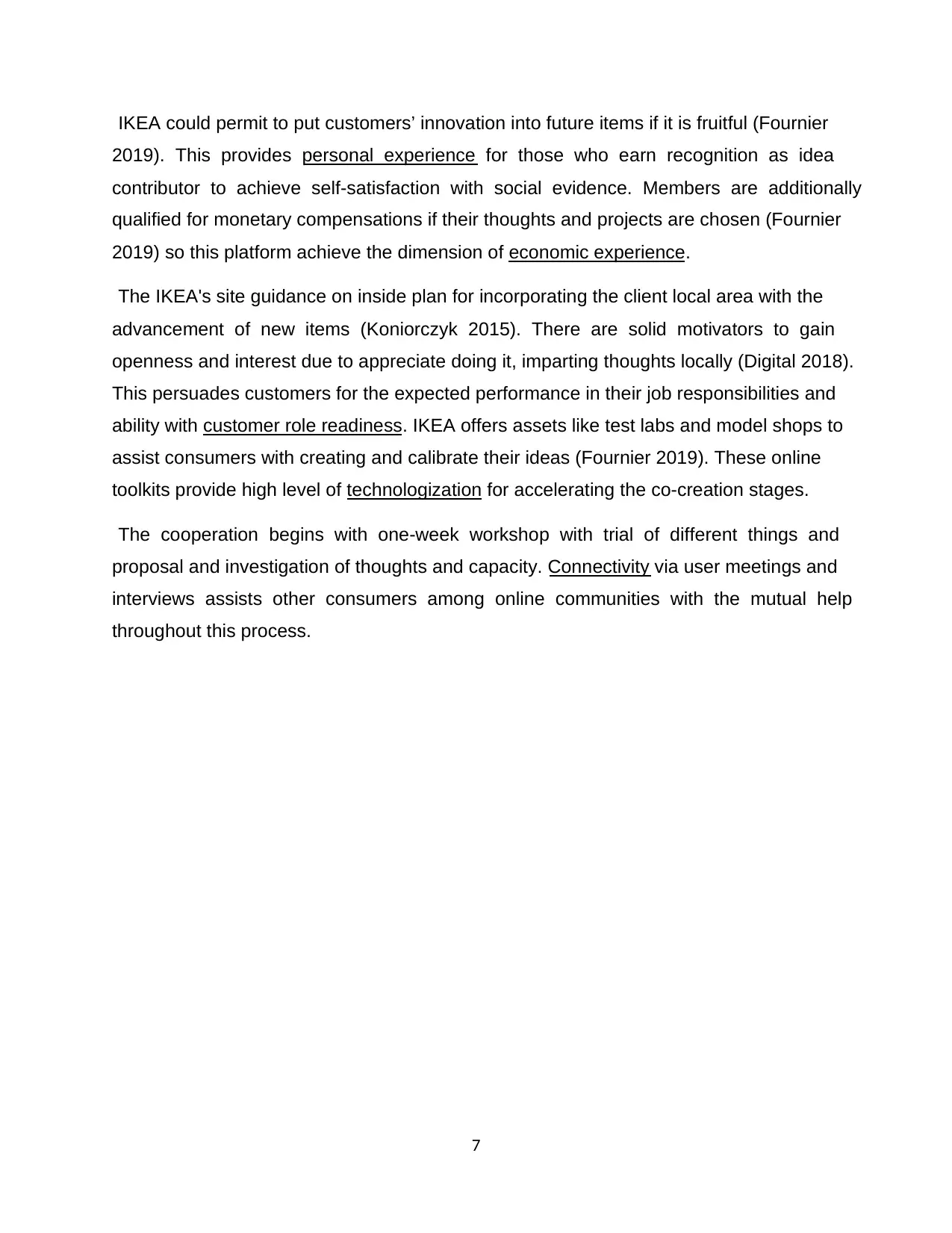
7
“IKEA could permit to put customers’ innovation into future items if it is fruitful (Fournier
2019). This provides personal experience for those who earn recognition as idea
contributor to achieve self-satisfaction with social evidence. Members are additionally
qualified for monetary compensations if their thoughts and projects are chosen (Fournier
2019) so this platform achieve the dimension of economic experience.”
“The IKEA's site guidance on inside plan for incorporating the client local area with the
advancement of new items (Koniorczyk 2015). There are solid motivators to gain
openness and interest due to appreciate doing it, imparting thoughts locally (Digital 2018).
This persuades customers for the expected performance in their job responsibilities and
ability with customer role readiness. IKEA offers assets like test labs and model shops to
assist consumers with creating and calibrate their ideas (Fournier 2019). These online
toolkits provide high level of technologization for accelerating the co-creation stages.”
“The cooperation begins with one-week workshop with trial of different things and
proposal and investigation of thoughts and capacity. Connectivity via user meetings and
interviews assists other consumers among online communities with the mutual help
throughout this process.”
“IKEA could permit to put customers’ innovation into future items if it is fruitful (Fournier
2019). This provides personal experience for those who earn recognition as idea
contributor to achieve self-satisfaction with social evidence. Members are additionally
qualified for monetary compensations if their thoughts and projects are chosen (Fournier
2019) so this platform achieve the dimension of economic experience.”
“The IKEA's site guidance on inside plan for incorporating the client local area with the
advancement of new items (Koniorczyk 2015). There are solid motivators to gain
openness and interest due to appreciate doing it, imparting thoughts locally (Digital 2018).
This persuades customers for the expected performance in their job responsibilities and
ability with customer role readiness. IKEA offers assets like test labs and model shops to
assist consumers with creating and calibrate their ideas (Fournier 2019). These online
toolkits provide high level of technologization for accelerating the co-creation stages.”
“The cooperation begins with one-week workshop with trial of different things and
proposal and investigation of thoughts and capacity. Connectivity via user meetings and
interviews assists other consumers among online communities with the mutual help
throughout this process.”
Paraphrase This Document
Need a fresh take? Get an instant paraphrase of this document with our AI Paraphraser
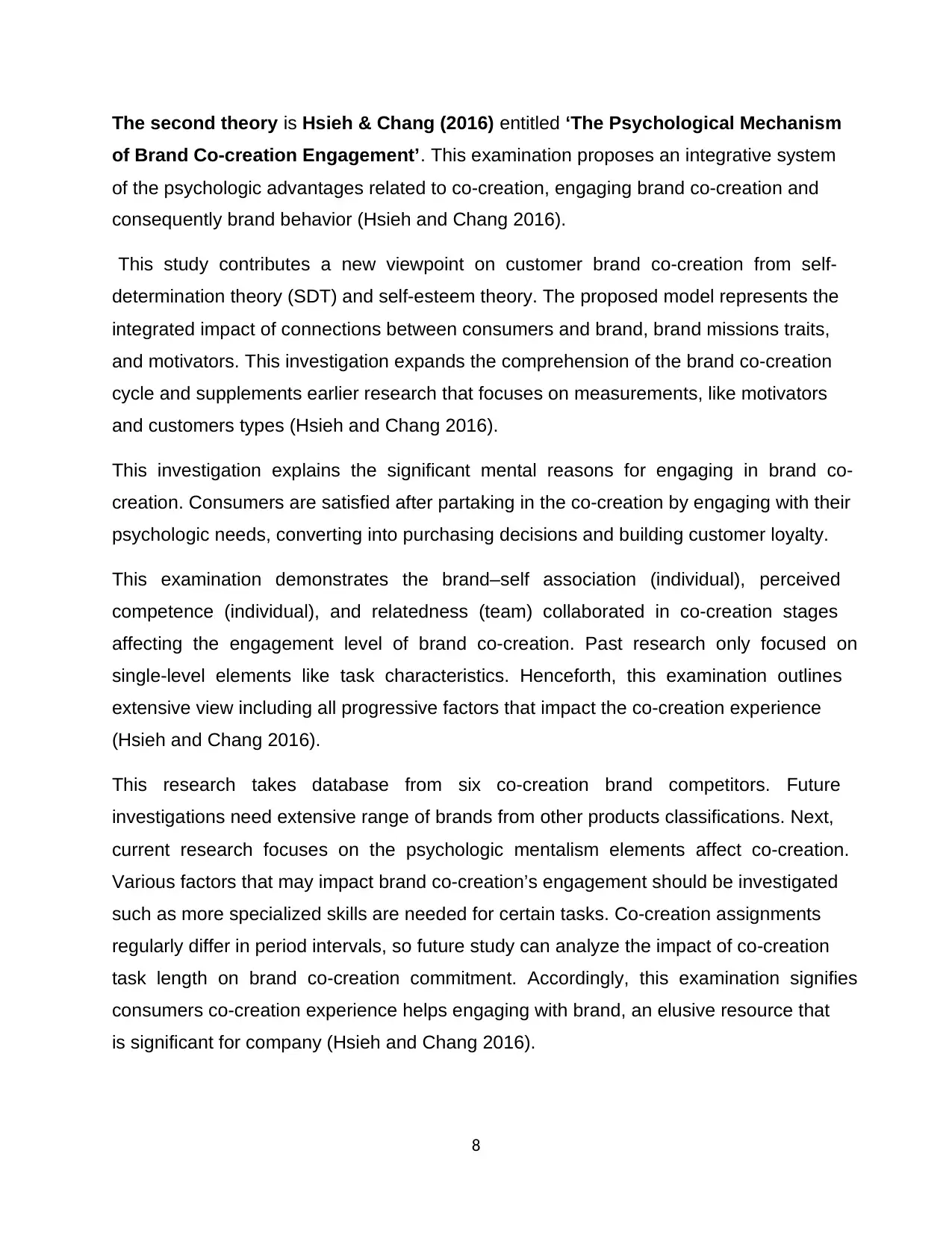
8
The second theory is Hsieh & Chang (2016) entitled ‘The Psychological Mechanism
of Brand Co-creation Engagement’. This examination proposes an integrative system
of the psychologic advantages related to co-creation, engaging brand co-creation and
consequently brand behavior (Hsieh and Chang 2016).
“This study contributes a new viewpoint on customer brand co-creation from self-
determination theory (SDT) and self-esteem theory. The proposed model represents the
integrated impact of connections between consumers and brand, brand missions traits,
and motivators. This investigation expands the comprehension of the brand co-creation
cycle and supplements earlier research that focuses on measurements, like motivators
and customers types (Hsieh and Chang 2016).”
This investigation explains the significant mental reasons for engaging in brand co-
creation. Consumers are satisfied after partaking in the co-creation by engaging with their
psychologic needs, converting into purchasing decisions and building customer loyalty.
This examination demonstrates the brand–self association (individual), perceived
competence (individual), and relatedness (team) collaborated in co-creation stages
affecting the engagement level of brand co-creation. Past research only focused on
single-level elements like task characteristics. Henceforth, this examination outlines
extensive view including all progressive factors that impact the co-creation experience
(Hsieh and Chang 2016).
This research takes database from six co-creation brand competitors. Future
investigations need extensive range of brands from other products classifications. Next,
current research focuses on the psychologic mentalism elements affect co-creation.
Various factors that may impact brand co-creation’s engagement should be investigated
such as more specialized skills are needed for certain tasks. Co-creation assignments
regularly differ in period intervals, so future study can analyze the impact of co-creation
task length on brand co-creation commitment. Accordingly, this examination signifies
consumers co-creation experience helps engaging with brand, an elusive resource that
is significant for company (Hsieh and Chang 2016).
The second theory is Hsieh & Chang (2016) entitled ‘The Psychological Mechanism
of Brand Co-creation Engagement’. This examination proposes an integrative system
of the psychologic advantages related to co-creation, engaging brand co-creation and
consequently brand behavior (Hsieh and Chang 2016).
“This study contributes a new viewpoint on customer brand co-creation from self-
determination theory (SDT) and self-esteem theory. The proposed model represents the
integrated impact of connections between consumers and brand, brand missions traits,
and motivators. This investigation expands the comprehension of the brand co-creation
cycle and supplements earlier research that focuses on measurements, like motivators
and customers types (Hsieh and Chang 2016).”
This investigation explains the significant mental reasons for engaging in brand co-
creation. Consumers are satisfied after partaking in the co-creation by engaging with their
psychologic needs, converting into purchasing decisions and building customer loyalty.
This examination demonstrates the brand–self association (individual), perceived
competence (individual), and relatedness (team) collaborated in co-creation stages
affecting the engagement level of brand co-creation. Past research only focused on
single-level elements like task characteristics. Henceforth, this examination outlines
extensive view including all progressive factors that impact the co-creation experience
(Hsieh and Chang 2016).
This research takes database from six co-creation brand competitors. Future
investigations need extensive range of brands from other products classifications. Next,
current research focuses on the psychologic mentalism elements affect co-creation.
Various factors that may impact brand co-creation’s engagement should be investigated
such as more specialized skills are needed for certain tasks. Co-creation assignments
regularly differ in period intervals, so future study can analyze the impact of co-creation
task length on brand co-creation commitment. Accordingly, this examination signifies
consumers co-creation experience helps engaging with brand, an elusive resource that
is significant for company (Hsieh and Chang 2016).
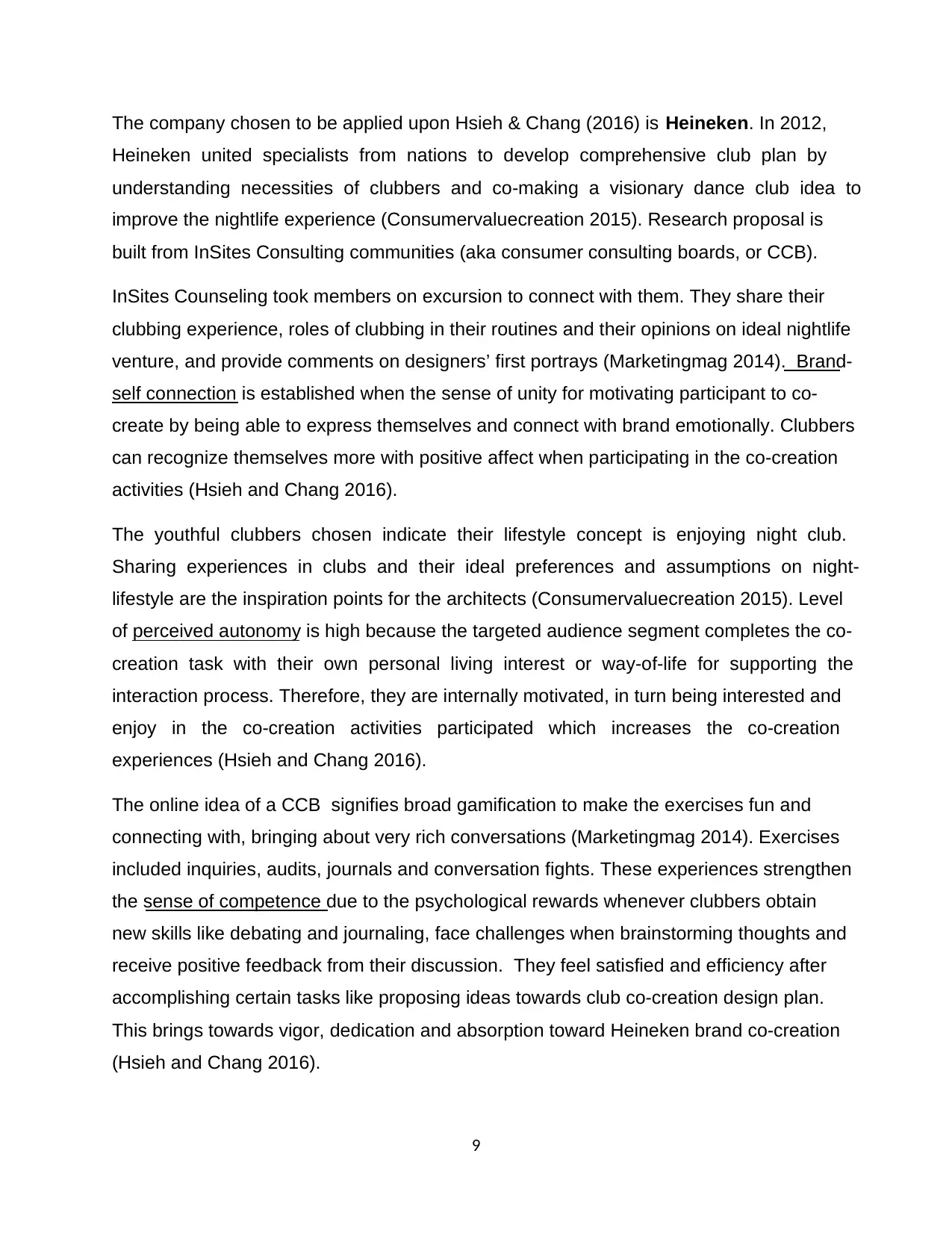
9
The company chosen to be applied upon Hsieh & Chang (2016) is Heineken. In 2012,
Heineken united specialists from nations to develop comprehensive club plan by
understanding necessities of clubbers and co-making a visionary dance club idea to
improve the nightlife experience (Consumervaluecreation 2015). Research proposal is
built from InSites Consulting communities (aka consumer consulting boards, or CCB).
InSites Counseling took members on excursion to connect with them. They share their
clubbing experience, roles of clubbing in their routines and their opinions on ideal nightlife
venture, and provide comments on designers’ first portrays (Marketingmag 2014). Brand-
self connection is established when the sense of unity for motivating participant to co-
create by being able to express themselves and connect with brand emotionally. Clubbers
can recognize themselves more with positive affect when participating in the co-creation
activities (Hsieh and Chang 2016).
The youthful clubbers chosen indicate their lifestyle concept is enjoying night club.
Sharing experiences in clubs and their ideal preferences and assumptions on night-
lifestyle are the inspiration points for the architects (Consumervaluecreation 2015). Level
of perceived autonomy is high because the targeted audience segment completes the co-
creation task with their own personal living interest or way-of-life for supporting the
interaction process. Therefore, they are internally motivated, in turn being interested and
enjoy in the co-creation activities participated which increases the co-creation
experiences (Hsieh and Chang 2016).
The online idea of a CCB signifies broad gamification to make the exercises fun and
connecting with, bringing about very rich conversations (Marketingmag 2014). Exercises
included inquiries, audits, journals and conversation fights. These experiences strengthen
the sense of competence due to the psychological rewards whenever clubbers obtain
new skills like debating and journaling, face challenges when brainstorming thoughts and
receive positive feedback from their discussion. They feel satisfied and efficiency after
accomplishing certain tasks like proposing ideas towards club co-creation design plan.
This brings towards vigor, dedication and absorption toward Heineken brand co-creation
(Hsieh and Chang 2016).
The company chosen to be applied upon Hsieh & Chang (2016) is Heineken. In 2012,
Heineken united specialists from nations to develop comprehensive club plan by
understanding necessities of clubbers and co-making a visionary dance club idea to
improve the nightlife experience (Consumervaluecreation 2015). Research proposal is
built from InSites Consulting communities (aka consumer consulting boards, or CCB).
InSites Counseling took members on excursion to connect with them. They share their
clubbing experience, roles of clubbing in their routines and their opinions on ideal nightlife
venture, and provide comments on designers’ first portrays (Marketingmag 2014). Brand-
self connection is established when the sense of unity for motivating participant to co-
create by being able to express themselves and connect with brand emotionally. Clubbers
can recognize themselves more with positive affect when participating in the co-creation
activities (Hsieh and Chang 2016).
The youthful clubbers chosen indicate their lifestyle concept is enjoying night club.
Sharing experiences in clubs and their ideal preferences and assumptions on night-
lifestyle are the inspiration points for the architects (Consumervaluecreation 2015). Level
of perceived autonomy is high because the targeted audience segment completes the co-
creation task with their own personal living interest or way-of-life for supporting the
interaction process. Therefore, they are internally motivated, in turn being interested and
enjoy in the co-creation activities participated which increases the co-creation
experiences (Hsieh and Chang 2016).
The online idea of a CCB signifies broad gamification to make the exercises fun and
connecting with, bringing about very rich conversations (Marketingmag 2014). Exercises
included inquiries, audits, journals and conversation fights. These experiences strengthen
the sense of competence due to the psychological rewards whenever clubbers obtain
new skills like debating and journaling, face challenges when brainstorming thoughts and
receive positive feedback from their discussion. They feel satisfied and efficiency after
accomplishing certain tasks like proposing ideas towards club co-creation design plan.
This brings towards vigor, dedication and absorption toward Heineken brand co-creation
(Hsieh and Chang 2016).
⊘ This is a preview!⊘
Do you want full access?
Subscribe today to unlock all pages.

Trusted by 1+ million students worldwide
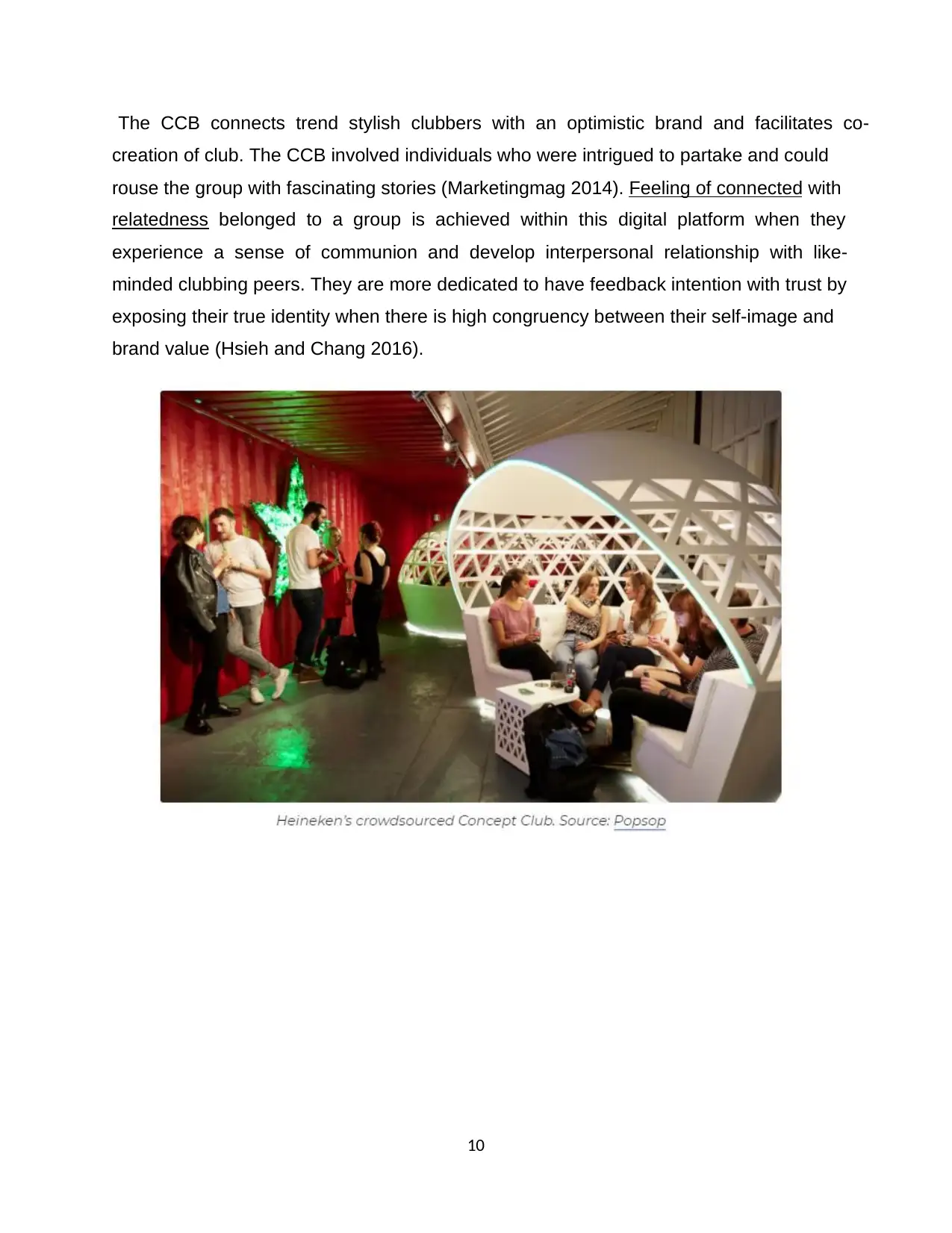
10
“The CCB connects trend stylish clubbers with an optimistic brand and facilitates co-
creation of club. The CCB involved individuals who were intrigued to partake and could
rouse the group with fascinating stories (Marketingmag 2014). Feeling of connected with
relatedness belonged to a group is achieved within this digital platform when they
experience a sense of communion and develop interpersonal relationship with like-
minded clubbing peers. They are more dedicated to have feedback intention with trust by
exposing their true identity when there is high congruency between their self-image and
brand value (Hsieh and Chang 2016).”
“The CCB connects trend stylish clubbers with an optimistic brand and facilitates co-
creation of club. The CCB involved individuals who were intrigued to partake and could
rouse the group with fascinating stories (Marketingmag 2014). Feeling of connected with
relatedness belonged to a group is achieved within this digital platform when they
experience a sense of communion and develop interpersonal relationship with like-
minded clubbing peers. They are more dedicated to have feedback intention with trust by
exposing their true identity when there is high congruency between their self-image and
brand value (Hsieh and Chang 2016).”
Paraphrase This Document
Need a fresh take? Get an instant paraphrase of this document with our AI Paraphraser
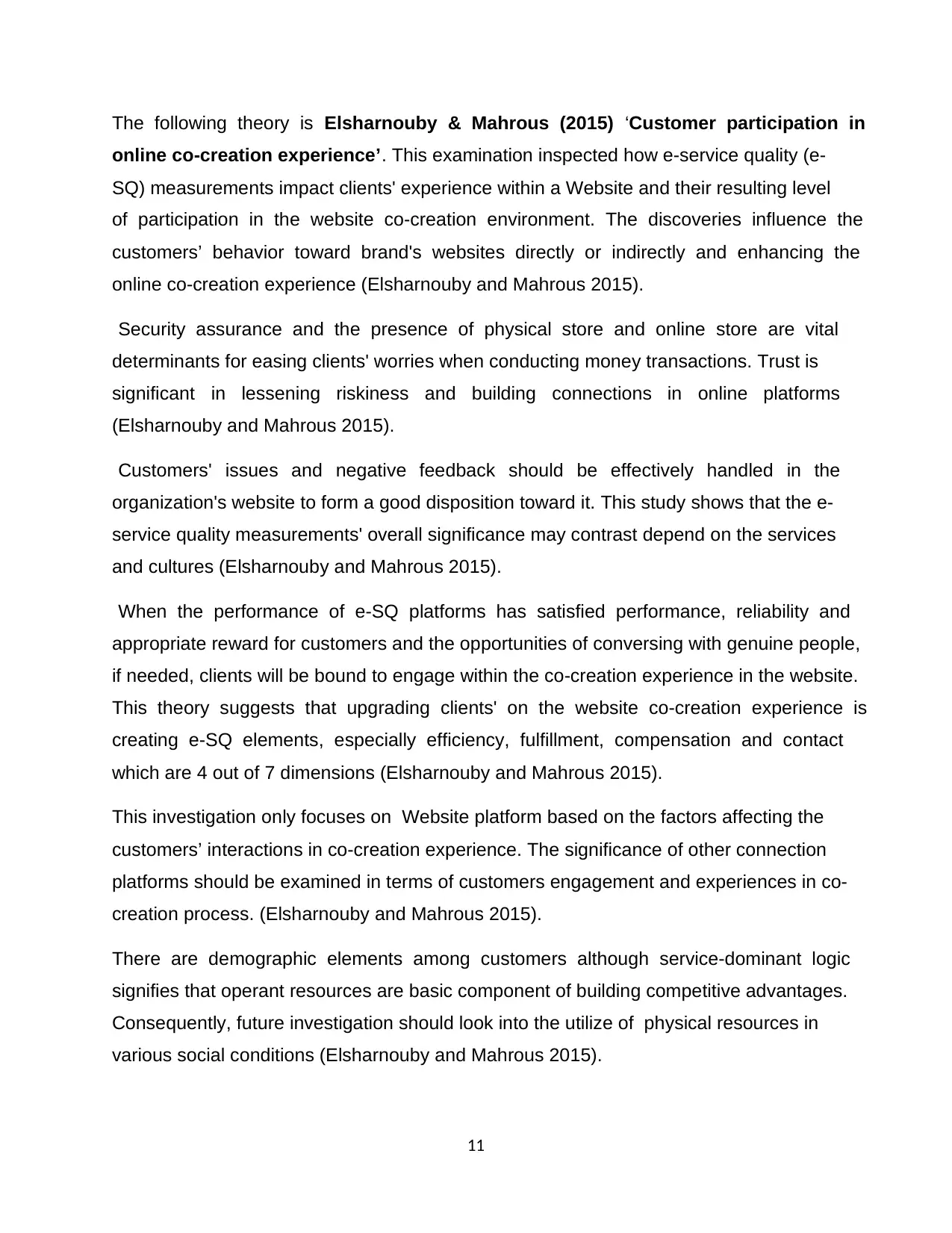
11
The following theory is Elsharnouby & Mahrous (2015) ‘Customer participation in
online co-creation experience’. This examination inspected how e-service quality (e-
SQ) measurements impact clients' experience within a Website and their resulting level
of participation in the website co-creation environment. The discoveries influence the
customers’ behavior toward brand's websites directly or indirectly and enhancing the
online co-creation experience (Elsharnouby and Mahrous 2015).
“Security assurance and the presence of physical store and online store are vital
determinants for easing clients' worries when conducting money transactions. Trust is
significant in lessening riskiness and building connections in online platforms
(Elsharnouby and Mahrous 2015).”
“Customers' issues and negative feedback should be effectively handled in the
organization's website to form a good disposition toward it. This study shows that the e-
service quality measurements' overall significance may contrast depend on the services
and cultures (Elsharnouby and Mahrous 2015).”
“When the performance of e-SQ platforms has satisfied performance, reliability and
appropriate reward for customers and the opportunities of conversing with genuine people,
if needed, clients will be bound to engage within the co-creation experience in the website.
This theory suggests that upgrading clients' on the website co-creation experience is
creating e-SQ elements, especially efficiency, fulfillment, compensation and contact
which are 4 out of 7 dimensions (Elsharnouby and Mahrous 2015).”
This investigation only focuses on Website platform based on the factors affecting the
customers’ interactions in co-creation experience. The significance of other connection
platforms should be examined in terms of customers engagement and experiences in co-
creation process. (Elsharnouby and Mahrous 2015).
There are demographic elements among customers although service-dominant logic
signifies that operant resources are basic component of building competitive advantages.
Consequently, future investigation should look into the utilize of physical resources in
various social conditions (Elsharnouby and Mahrous 2015).
The following theory is Elsharnouby & Mahrous (2015) ‘Customer participation in
online co-creation experience’. This examination inspected how e-service quality (e-
SQ) measurements impact clients' experience within a Website and their resulting level
of participation in the website co-creation environment. The discoveries influence the
customers’ behavior toward brand's websites directly or indirectly and enhancing the
online co-creation experience (Elsharnouby and Mahrous 2015).
“Security assurance and the presence of physical store and online store are vital
determinants for easing clients' worries when conducting money transactions. Trust is
significant in lessening riskiness and building connections in online platforms
(Elsharnouby and Mahrous 2015).”
“Customers' issues and negative feedback should be effectively handled in the
organization's website to form a good disposition toward it. This study shows that the e-
service quality measurements' overall significance may contrast depend on the services
and cultures (Elsharnouby and Mahrous 2015).”
“When the performance of e-SQ platforms has satisfied performance, reliability and
appropriate reward for customers and the opportunities of conversing with genuine people,
if needed, clients will be bound to engage within the co-creation experience in the website.
This theory suggests that upgrading clients' on the website co-creation experience is
creating e-SQ elements, especially efficiency, fulfillment, compensation and contact
which are 4 out of 7 dimensions (Elsharnouby and Mahrous 2015).”
This investigation only focuses on Website platform based on the factors affecting the
customers’ interactions in co-creation experience. The significance of other connection
platforms should be examined in terms of customers engagement and experiences in co-
creation process. (Elsharnouby and Mahrous 2015).
There are demographic elements among customers although service-dominant logic
signifies that operant resources are basic component of building competitive advantages.
Consequently, future investigation should look into the utilize of physical resources in
various social conditions (Elsharnouby and Mahrous 2015).
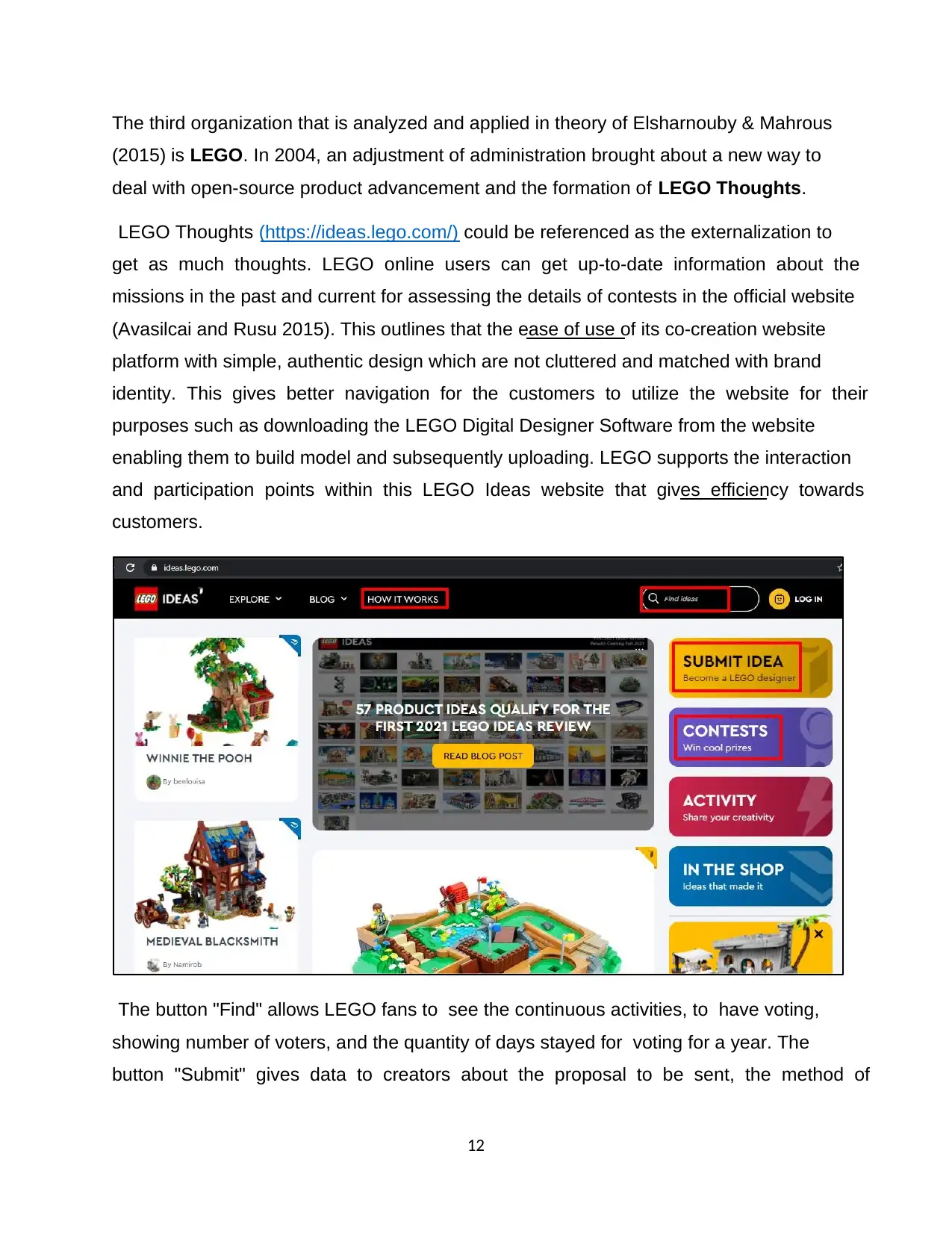
12
The third organization that is analyzed and applied in theory of Elsharnouby & Mahrous
(2015) is LEGO. In 2004, an adjustment of administration brought about a new way to
deal with open-source product advancement and the formation of LEGO Thoughts.
“LEGO Thoughts (https://ideas.lego.com/) could be referenced as the externalization to
get as much thoughts. LEGO online users can get up-to-date information about the
missions in the past and current for assessing the details of contests in the official website
(Avasilcai and Rusu 2015). This outlines that the ease of use of its co-creation website
platform with simple, authentic design which are not cluttered and matched with brand
identity. This gives better navigation for the customers to utilize the website for their
purposes such as downloading the LEGO Digital Designer Software from the website
enabling them to build model and subsequently uploading. LEGO supports the interaction
and participation points within this LEGO Ideas website that gives efficiency towards
customers.”
“The button "Find" allows LEGO fans to see the continuous activities, to have voting,
showing number of voters, and the quantity of days stayed for voting for a year. The
button "Submit" gives data to creators about the proposal to be sent, the method of
The third organization that is analyzed and applied in theory of Elsharnouby & Mahrous
(2015) is LEGO. In 2004, an adjustment of administration brought about a new way to
deal with open-source product advancement and the formation of LEGO Thoughts.
“LEGO Thoughts (https://ideas.lego.com/) could be referenced as the externalization to
get as much thoughts. LEGO online users can get up-to-date information about the
missions in the past and current for assessing the details of contests in the official website
(Avasilcai and Rusu 2015). This outlines that the ease of use of its co-creation website
platform with simple, authentic design which are not cluttered and matched with brand
identity. This gives better navigation for the customers to utilize the website for their
purposes such as downloading the LEGO Digital Designer Software from the website
enabling them to build model and subsequently uploading. LEGO supports the interaction
and participation points within this LEGO Ideas website that gives efficiency towards
customers.”
“The button "Find" allows LEGO fans to see the continuous activities, to have voting,
showing number of voters, and the quantity of days stayed for voting for a year. The
button "Submit" gives data to creators about the proposal to be sent, the method of
⊘ This is a preview!⊘
Do you want full access?
Subscribe today to unlock all pages.

Trusted by 1+ million students worldwide
1 out of 17
Related Documents
Your All-in-One AI-Powered Toolkit for Academic Success.
+13062052269
info@desklib.com
Available 24*7 on WhatsApp / Email
![[object Object]](/_next/static/media/star-bottom.7253800d.svg)
Unlock your academic potential
Copyright © 2020–2025 A2Z Services. All Rights Reserved. Developed and managed by ZUCOL.




